Standing Desks: The Definitive Guide to Standing at Work
Below you will find a table of contents for each section so you can skip ahead as you like or you can go ahead and start from the beginning. Be sure to leave your comments below after reading about your experiences from sitting too much or making the switch to standing desks.
Table of Contents
- The Damage of Sitting Too Much
- The Benefits of Standing
- Disadvantages of Standing
- Bottom Line on Standing
- Types of Standing Desks
- Standing Desk Options
- Tips for Working at a Standing Desk
- Further Reading
The Damage of Sitting Too Much
Recent research has estimated that more than half of the average American's waking life is spent sitting (Source). During a typical day, most Americans can spend as much as 95% of their day sitting. In fact, office and administration employees spend approximately 80,000 hours of their working life sitting down (Source). That’s a very staggering number. That much sitting leads to an increase in obesity, lower HDL (good cholesterol), and a reduction in our metabolic rate.
While over the past few years, there have been numerous research studies reporting on the harmful effects of sitting for excessive periods, it can be confusing to understand just how bad sitting really is. Some studies suggest that sitting is a lethal activity and it has even been compared to the smoking of our generation. We all seem to know it’s bad but we do it without thought anyways. Then there are some who argue, it’s not sitting that is really doing us in, it's being completely stationary and our lack of movement, whether we are standing or sitting.
However, it’s clear that too much sitting is damaging. Even if you aren’t aware of the stats, many of us know its ill effects. Sore hips, back, neck, and shoulder pain all result from too much sitting.
When you sit, all sorts of activities in your body begin to shut down. The electrical activity in your leg muscles shuts off, calorie burning drops to 1 per minute, enzymes that help break down fat drop 90%, and after two hours of sitting, good cholesterol drops 20% (Source).
Image Source: Kybun
On top of that, sitting 6 or more hours per day increases your chance of dieing within 15 years by 40% compared to someone who sits less than 3 hours. Even with exercise. It’s also found that obese people tend to sit for 2.5 hours more than thin people. And finally, people who have jobs where they spend most of their time sitting have twice the rate of cardiovascular disease as people with standing jobs (Source).
In addition, in a study of more than 17,000 men and women taken place over the course of 13 years, scientists found that people who sit for most of the day are 54% likely to die of heart attacks (Source).
You may be thinking “well, all of that doesn’t really apply to me because I exercise regularly, so I offset any of those harmful effects of sitting”. Wrong. Researchers at the American Cancer Society claim that sitting is so bad that its damaging effects can not be overcome by regular exercise.
Studies have found that people who cap off their day with an intense workout yet still spend the majority of their day sitting, were estimated to be 16% more likely to die of any cause in a given time than those people who did not sit for long (Source).
“It doesn’t matter if you go running every morning, or you’re a regular at the gym. If you spend most of the rest of the day sitting—in your car, your office chair, on your sofa at home—you are putting yourself at increased risk of obesity, diabetes, heart disease, a variety of cancers and an early death. In other words, irrespective of whether you exercise vigorously, sitting for long periods is bad for you.” - Olivia Judson, Evolutionary Biologist at Imperial College London (Source)
Additional Resources:
- https://www.latimes.com/science/sciencenow/la-sci-sn-sitting-health-20150119-story.html
- https://www.msnbc.msn.com/id/38385104/ns/health-fitness/
The Benefits of Standing
Although, too much standing can induce new problems (see Disadvantages of Standing section), there are many health benefits that go along with standing at work instead of sitting.
Many standing desk users report feeling less sluggish after a day of standing as compared to sitting. It often gives them more energy and makes them feel better about themselves. Standing can even improve overall mood. In a 7 week study on standing desk use, participants reported feeling less fatigue, tension, confusion, and depression. Participants also reported having more energy and feeling happier in general (Source).
"I like the standing desk because it allows me to move around and stretch my legs. It boosts my energy and makes me more alive sounding on the phones. Its easier to walk around and come back to my desk to jump on the computer." - Josh Borowiec, Simplified Building Technical Support
Standing can also help with posture. When we sit down all day, we tend to slouch in our chair. When standing, you can position the desk to allow yourself to stand straight up and eradicate any slouching. A standing desk that is correctly set to your height will also allow your arms to be relaxed and positioned at a 90 degree angle for more comfortable typing.
One big problem that many of us have with excessive sitting is the back, neck, hip, and shoulder pain that comes with it. Standing can help to reduce pain in many of these problems areas. One research study found that participants reported a 32% improvement in lower back pain after just a few weeks of standing. Another study conducted by the CDC, found that participants who use a sit-stand desk, reduced upper back and neck pain by 54% in 4 weeks (Source).
"I've had jobs before where there wasn't the option to use a standing desk, and I just remember feeling super restless after sitting all day. I heard sitting all day is just as bad for your body as smoking is to your lungs (not sure if that is a myth or not), and I've always had back problems, so I thought a standing desk would be a good solution. So far it has been! It forces me to work on my posture, because when I sit, I'm slouching all the time. This is probably what causes my back problems. With a standing desk, it reduces that problem. It also gives me the freedom to move my feet, stretch my legs etc., as opposed to sitting all day and being in one posture." - Vivien Reed, Simplified Building Administrative Assistant
This improvement could be caused by an overall increase in movement. Standing allows you to move around more and change up your position rather than staying in one position. It could also be caused by the increase in blood flow and circulation in the body that happens when you stand. When you sit, your body has to fight to keep everything running smoothly. Standing, however, naturally allows for better circulation and blood flow in the body. This increase in blood flow can cause muscle aches and pain to subside much in the same way that a massage heals aching muscles.
And while we're on the topic, an increase in blood flow due to standing can even help you feel smarter and sharper. Since more oxygen and blood is circulating to your brain, it can help you to feel more focused and productive.
Another big benefit to standing versus sitting, is the extra calorie burn you get from standing. Humans burn an extra 60 calories per hour when standing. If you were to stand for just two hours a day, this could translate to roughly 20 pounds of weight loss over the course of a year (Source).
And finally, standing more may even cause you to live longer. One study estimated that reducing sitting time by 3 hours a day could raise the average American's life expectancy by 2 years (Source).
Additional Resources:
Disadvantages of Standing
While standing is a great solution to get off your ass and start to fight the harmful effects of sitting, it’s still not a perfect solution. In fact, many have argued that standing all day can be nearly as bad as sitting all day.
Standing too much can cause the spine to compress and lead to lower back problems. It also increases your risk for varicose veins, carotid arteries, and other cardiovascular problems. In addition, standing for long periods of time is tiring and can put a lot of stress on the body.
Standing can also affect the quality of your work. When standing, the performance of many fine motor skills decreases as compared to sitting. This can make it difficult to focus on more mind intensive work such as writing and typing. Especially, if you’re not in shape or use to standing for long periods of time. It’s hard to focus on certain tasks when the muscles in your leg begin to hurt.
Another problem for those who stand while working, is getting your posture and the ergonomics of the desk just right. If your standing desk is not tuned properly to your height, it can introduce new problems such as pain in your neck due to an incorrect monitor height or pain in your hand and wrists if the desk height is too high.
Additional Resources:
- https://health.usnews.com/health-news/health-wellness/articles/2015/02/17/4-ways-your-standing-desk-is-doing-more-harm-than-good
- https://healthland.time.com/2011/04/13/the-dangers-of-sitting-at-work%E2%80%94and-standing/
- https://qz.com/272350/theres-a-huge-hidden-downside-to-standing-desks-that-no-one-told-me-about-2/
Bottom Line on Standing
So if sitting all day is bad for you, but standing all day isn’t much better either, what’s the solution? Scientists say a bit of both in combination with more movement in general.
In fact, many researchers argue that our sedentary lifestyle and lack of movement in general is what’s really doing us in. Constantly being stuck in one position is what’s really bad for our body.
“It doesn’t matter if you’re standing or sitting, if you’re doing it statically, your body wasn’t designed that way. You need to move.” Ken Tameling - Ergonomic Seating Expert at Steelcase (Source)
The solution: mix up your position and get moving. Movement is the best weapon against excessive sitting and a sedentary lifestyle.
“If you go from sitting to standing and vice versa frequently throughout the day … that completely eradicates any of the supposed risk factors associated with sitting, or indeed with standing,” - Alan Hedge, Professor in the Department of Design and Environment Analysis at Cornell University (Source)
So if you want to mix up your movement and positions more often, standing desks really give you the best chance to do that. It's easier to change between sitting and standing throughout the day with a standing desk. But you may be wondering how much should you be sitting and how much should you be standing.
While there is no clear number for how you should be splitting your day, research has supported standing for at least two hours during a work day and then gradually move up to four. The people over at Men's Health have claimed that you should aim for a fifty-fifty split of standing and sitting throughout the day.
In any case, you should be aiming to mix it up as much as possible. Stand for bit here, sit, stretch, move around. Mix it up as much as possible..
"Movement, no matter how small, is the best way to combat excessive sitting." - The Wirecutter
Types of Standing Desks
So now that you know all about the harmful effects of sitting, the benefits of standing, and everything in between, we want to highlight the different types of standing desks out there. The most common are: Fixed Height Standing Desk, Adjustable Height Desk, Add-On Standing Desk, and Treadmill Desk.
Fixed Height Standing Desk
The fixed height standing desk is positioned at a height for the user to stand at without the ability to adjust the height of the desk. The advantage of picking this type of standing desk is typically that it's less expensive than an adjustable desk.
However, when ordering your fixed height standing desk you need to be certain of the height it will need to be set at. Ideally, you want the desk table top to sit at a height that allows your arms to create a 90 degree angle when typing.
The above and below options were built using one of our table kits.
The video below shows a closer look at how the desk comes together using pipe and fittings.
Adjustable Height Desk
The adjustable height desk is adjustable from a range of height typically allowing you to position it as a sitting or standing desk. Some adjustable height desks, like the one pictured above have to be adjusted manually. The one above is adjusted in height by loosening a set screw, adjusting the height of the leg, and then tightening back down the set screw. You would repeat this process for all legs of the desk. This allows you to adjust the height of the desk from sitting to standing or vice versa.
You can position the desk at a height that works for any user, whether they decide to stand or sit. It's great for office environments when you may change employees. New employees can set the desk up to the height they find most comfortable.
Some adjustable height desks, like the one pictured below, feature a motorized or even hydraulic function that can adjust the height of the desk at the push of a button. This allows you to constantly adjust the height of the desk throughout the day. You can sit for some of your work day and stand for the rest. The downfall of a desk like this is that they can be rather costly.
Image Source: Office Snapshots
Treadmill Desk
By using a standing desk, users can increase their physical activity by adding a treadmill. The treadmill standing desk simply utilizes a standing desk, whether fixed or adjustable, with a treadmill for walking on while at the desk. It's a great way to add more movement to your work day.
Add-On Standing Desk
The add-on desk allows you to add a standing desk to your existing, sitting desk. The advantage of a setup like this is typically that it is less expensive than buying a new standing or adjustable height desk. It can be a lasting solution or it can give you a chance to try out standing before fully investing in a new standing desk.
The above add-on was built using Kee Klamp fittings and pipe. It features a platform for the keyboard and mouse while attaching a monitor to the frame itself. We discuss more add-on options below.
Options for Standing Desks
Below we discuss a few popular options for standing desks. We highlight a few add-on options as well as adjustable height desks. They are ordered from least to most expensive.
The Standesk 2200
Image Source: Modern Luxury
Overview:
While the Standesk 2200 may sound fancy, it is anything but that. However, it does offer new standing desk users a chance to try out standing before investing too much money. The desk is essentially made of a few different IKEA pieces to form a platform that can be placed on your existing desk to transform it into a standing desk. You can see the instructions here.
Pros:
- Inexpensive solution to try out standing desks
Cons:
- Not the most sturdy or robust solution
- Not adjustable in height
Cost: $22
Oristand
Image Source: Gizmag
Overview:
The Oristand is another solution that you can use to add on to an existing sitting desk to transform it into a standing desk. It features two levels: one for you keyboard and mouse and another for your monitor to position it at eye level. It is made entirely from cardboard so it is not the most robust solution.
Pros:
- Inexpensive solution to try out standing desks
Cons:
- Not the most sturdy or robust solution
- Not adjustable in height
Cost: $25
Simple Table Adjustable Desk
Overview:
The Simple Table Adjustable Desk is an adjustable height desk that can be configured in adjustable height, length, and width upon order. The frame is built using Kee Klamp fittings and pipe that allow the desk to be adjusted in height by loosening and tightening the set screws to each leg. The pipe gives the desk an industrial finish and the table frame can be combined with nearly any table top.
Pros:
- Configurable in adjustable height, length, and width upon order
- Adjustable in height
- Very sturdy and stable solution
Cons:
- The price below is for the frame itself. A table top must be purchased separately which can add to the cost of the desk.
- Adjustment of height is manual
Cost: Starting at $220 for the frame
Kangaroo Pro Junior
Image Source: Ergo Desktop
Overview:
The Kangaroo Pro Junior allows you to transform your current desk into a standing desk. Rather than attaching to your desk, the Kangaroo Pro Junior simply rests on top to allow freedom to move the platform as you wish. This allows for a variety of different positions. Unlike the other add-on options shown above, the Kangaroo Pro Junior can be adjusted in height.
Pros:
- Adjustable in height
Cons:
- Can’t support full body weight (Can support 15 lbs of pressure)
- Expensive for an add-on solution
Cost: Starting at $399.00
Ergo Depot Jarvis Bamboo
Image Source: The Wirecutter
Overview:
The Ergo Depot Jarvis Bamboo is an adjustable height desk that offers a range of adjustment from 23" to 48". The desk features a motorized function that allows the desk to easily transition from sitting to standing height in a few seconds. The desk features a bamboo table top.
Pros:
- Adjustable in height
- Motors can lift up to 350 pounds
- Seven Year Warranty
Cons:
- Can get expensive with additional options upon ordering
Cost: Starting at $750.00
Steelcase Airtouch
Image Source: Steelcase
Overview:
The Steelcase Airtouch is an adjustable height desk that uses hydraulics rather than a motor to change the height of the desk from sitting to standing position. A bit more of a pricier solution compared to the Jarvis Bamboo, the Airtouch features a smooth adjustment that ranges from 26" - 43". Since the Airtouch doesn't require power, it can be used anywhere.
Pros:
- Adjustable in height
- Doesn't require electricity for adjustment
Cons:
- Smaller range of height adjustment compared to similar models
- Costly solution that may be out of most people's budget for a standing desk
Cost: Starting at $1479.00
Tips for Working at a Standing Desk
Below we highlight a few tips to make transitioning from a sitting desk to standing desk a smooth and easy one.
Start Small and/or Minimize Your Risk
If you’ve decided to try out a standing desk, you may want to consider starting with a smaller, less expensive solution. Many people seem to either hate or love working at standing desks and you won’t be sure which you are until you try working at one for some period of time. By starting with a less expensive solution, like an add-on, you can try it out for awhile without making too big of an investment.
Alternatively, you could go with a desk that is adjustable in height from a sitting to standing position. This way if you decide you aren’t loving standing while working, you can position the desk at a sitting position.
Use a Pad Under Your Feet
Image Source: Ergonomics Fix
Using a pad under your feet (often called an Anti-Fatigue mat) can help to alleviate some of the stress on your body from standing for long periods of time. Mats like this one conform to your feet and reduce pressure on your feet, knees and back.
Opt for a Drafting Chair
If you’re working at a standing desk that is not adjustable or not easy to adjust, we recommend opting for a drafting or similar chair. Drafting chairs are usually high enough to sit at when using a standing desk and can be used when you don’t feel like standing anymore. Alternatively, if you already have an office chair that you really like, you can transform it into a drafting chair by using a drafting chair kit.
We use these chairs in our office (pictured below). They allow those in the office who use standing desks to sit down and continue working at their desk whenever they need a break from standing.
Wear Comfortable Shoes
If your company or work environment allows it, try to wear the most comfortable footwear possible. Sneakers are preferred as they typically offer a fair amount of support and cushioning. But if your office won’t allow it, there are a few things you can do to make your footwear more comfortable. For men and women, try insoles with a bit more support and cushioning. It will make a difference when you're spending more of your time standing and on your feet throughout the day. For women specifically, try to avoid high heels and go with something flatter if possible.
Invest in a Separate Filing Cabinet and/or Drawer
Unlike most traditional desks, standing desk typically don’t offer a lot in the means of storage, if at all. So you’ll more than likely need some sort of filing cabinet or drawer to keep your workspace organized. If you want to keep some storage under the desk, opt for something that is lower than the lowest position you will set the desk at.
We use these 3 drawer units from IKEA in our office:
Stretch and/or Do Simple Exercises Throughout the Day
Like stated above, movement, not just standing, is the best way to combat the ill effects and pain caused by excessive sitting and being stationary. Stretching or doing simple exercises throughout the day are a great way to get your body moving and alleviate any issues.
For stretching, the hips are one of the most common problems areas for those who sit too much. Here are a few hip stretches you can do to help alleviate any pain or tightness:
The Art of Manliness blog also has a great post with stretches to do to undo the damage of sitting.
For simple exercises you can do throughout the day, air squats are a great way to get moving and improve the circulation in your legs. You can do them in between tasks, on breaks, or before you go to lunch.
Walking is another simple exercise you can do. Try to get up as often as you can and walk around for a few minutes. To the water cooler, to talk to a co-worker instead of email, or maybe even to a close by restaurant for lunch rather than driving there. Some companies even hold walking meetings to get everybody moving.
Focus on Certain Tasks While Sitting and Others While Standing
Some tasks will lend themselves better to do while standing and other will be easier to do when sitting. More menial tasks such as going through your inbox are easier to do while standing. However, more mind intensive tasks like writing are better left for when sitting.
Here's what a few of those in our office who use standing desks had to say:
"I sit when I am doing a repetitive or mundane task. If I am stuck doing a drawing for a while or sorting out my emails or writing up a complex quote, I will be sitting." - Josh Borowiec, Simplified Building Technical Support
"When I need to concentrate on a complicated project I do tend to sit, just because it helps me concentrate, but once I've got good rhythm going, I tend to stand up. I do find that I can't stand all day because it's hard on my feet, so it does help to have a tall chair. Lastly, moving from sitting to standing and vice versa, keeps me on my toes (no pun intended ;-0) . It helps me feel awake and motivated as opposed to sitting and working. That's just me though..." Vivien Reed, Simplified Building Administrative Assistant
Move Around More
Even if you made the transition towards a standing desk, it is often recommended to move around as much as possible. Dr. David Atler, a senior scientist at the Toronto Rehabilitation Institute, recommends getting up and moving around for one to three minutes about every half-hour.
Research has shown that simple movement such as walking around is sufficient enough to help combat excessive sitting. So make more of an effort to walk around more, use the stairs in your office, and simply get moving.
Of course you could always do this:

Image Source: Blogspot
Make Sure Your Posture is Correct
Image Source: Wired.com
Just like if you were sitting in your chair at a normal, sitting desk, if you're standing you want to make sure you have the right ergonomics and posture. The height of the desk should be high enough so that when typing your arms are rested and form a 90 degree angle. The monitor should sit higher so that it is at or just below eye level. You can raise the height of the monitor by placing it on a shelf, books, or using a monitor mount.
The above graphic helps to illustrate the correct posture you should try to achieve when standing at your desk. Correct posture will help to alleviate pain and discomfort when standing for longer periods.
Further Reading
Below are a few resources that we recommend reading if you would like to continue your research on standing desks, the harmful effects of sitting, and the benefits of standing.
Well, that's everything we have on standing desks, the benefits of standing, the harmful effects of sitting, and everything else in between. Let us know in the comment's section below what you think or if there was anything we missed. Also, be sure to comment on your own experiences with excessive sitting or on transitioning to a standing desk.

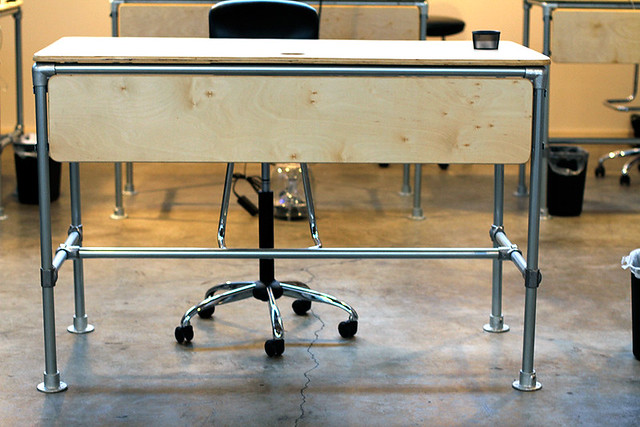
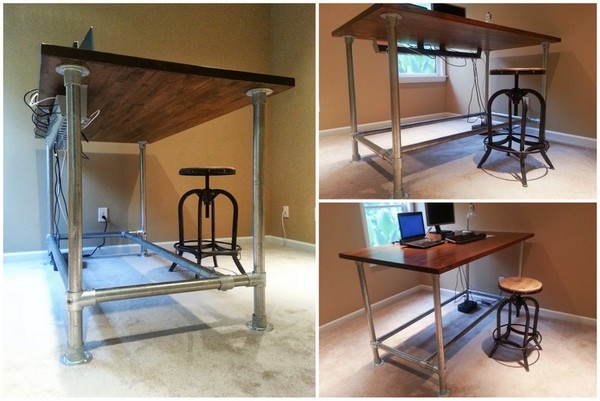
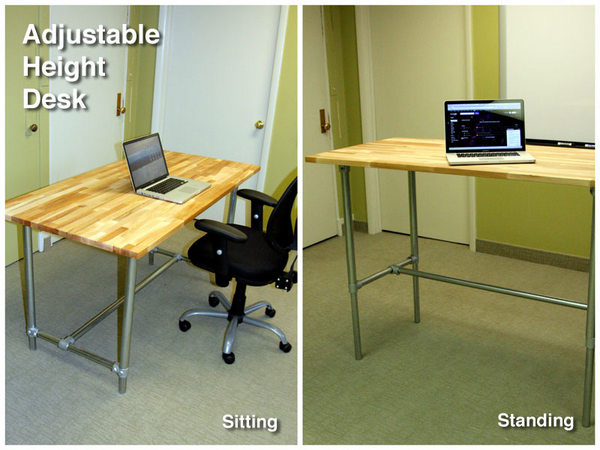

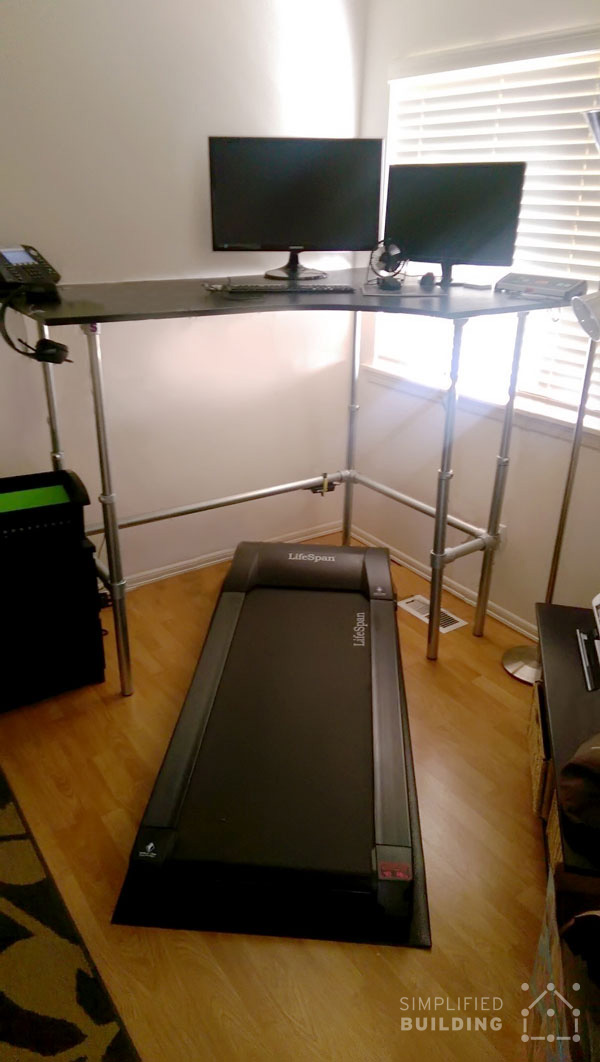
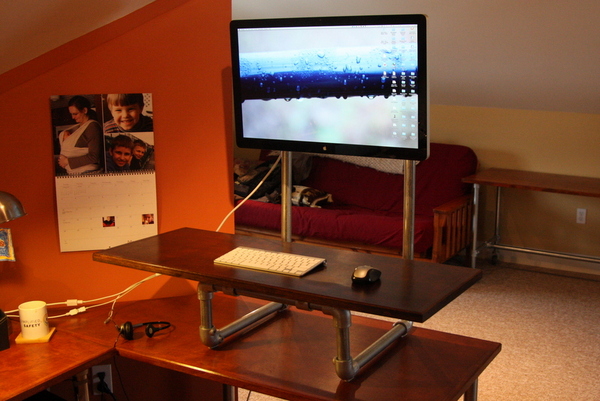
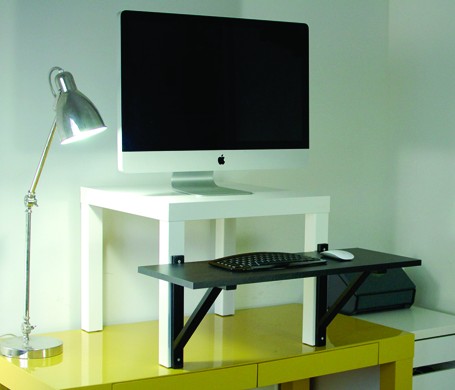
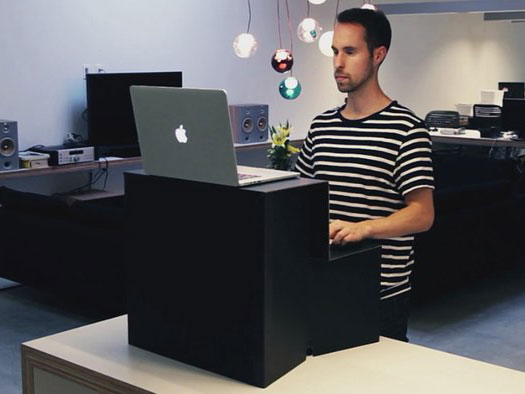
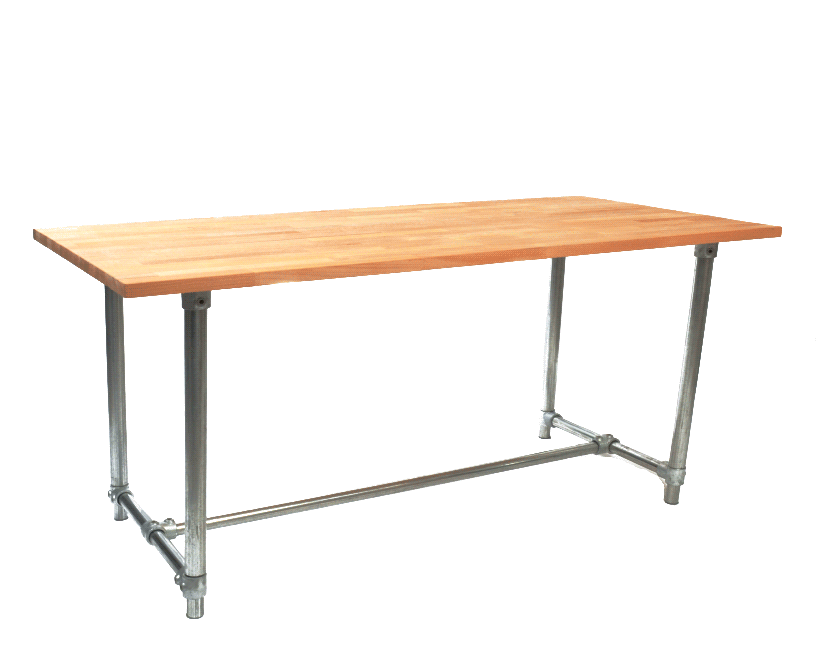


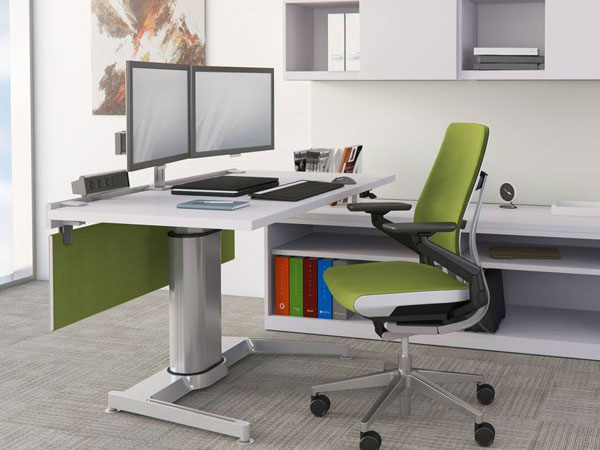
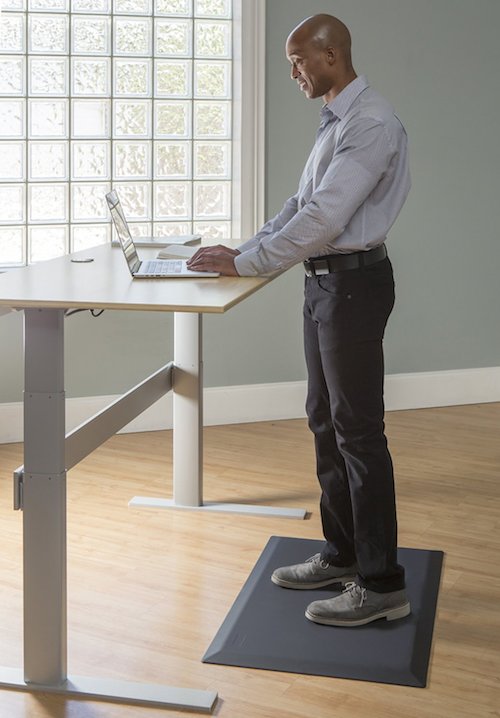
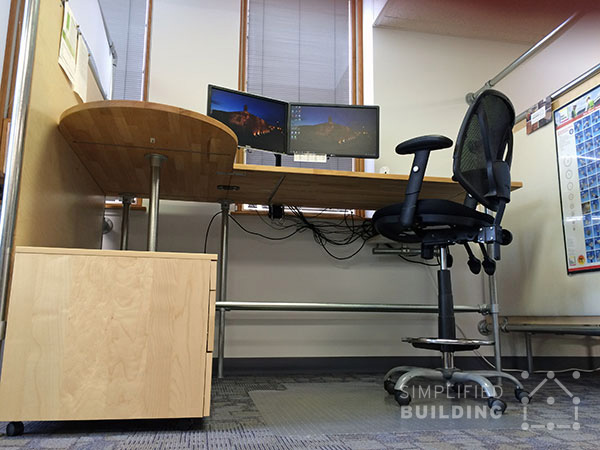


![Building an Adjustable Height Standing Desk [Video]](https://sbc-content.s3.amazonaws.com/catalog/product/cache/2/image/325x/040ec09b1e35df139433887a97daa66f/a/d/adjustable-standing-desk_1.jpg)


